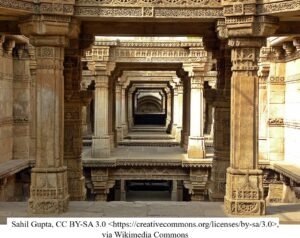पुरुषोत्तम योग Yoga of the Supreme Person
The Bhagwad Gita
Chapter 15
Sanjay Mehta
पुरुषोत्तम योग
Yoga of the Supreme Person
This chapter is an essence of Vedantic teaching. It elucidates the glory of Bhagwan and relationship of Bhagwan with the material world.
Bhagwan compares here the whole universe (Sansaar) to a juge ashwattha tree (fig/peepal tree) because of several common features between the tree and the universe.
Bhagwan said:
ऊर्ध्वमूलमध:शाखमश्वत्थम प्राहुरव्ययम् ;
छन्दासी यस्य पर्णानी यस्तान वेद स वेदवित || १ ||
Uurdhwamuulmadahshaakhamshwattham praahurvyayam ;
Chhandaasi yasya parnaani yastam veda sa vedavit
They speak of the imperishable Ashwattha tree as having its roots above and branches below, whose leaves are the Vedic hymns. The one who sees this reality, is alone a knower of the Vedic teachings.
Using a metaphor of peepal tree Bhagwan explains, how did world of matter arise from one consciousness? What nourishes and sustains it? What is the relationship between the Creator and the created?
Aswattha – ‘shwa’ means tomorrow, ‘tha’ means that which remains, therefore aswattha means that will not remain the same tomorrow, constantly changing. Even though it is ever changing it is called imperisshable as it originates from imperishable supreme reality (Bhagwan).
Tree is described as having its troots up. Up is in the sense of higher position, roots have their origin up in perishable supreme reality. Its branches are spread below and above, nourished by the guna-s, with buds as sense objects and roots/sub roots stretch below as actions (karma) that binds mankind to the world. The branches represent flow of life in individual as well as universe. Individuals’ nature is driven bu Guna-s as explained in Chapter 14. Those established in Sattva move upwards, the Rajas remain in the middle, Tamas go downward.
असङ्गशस्त्रेण दृढेन छित्वा , ततः पदं ततपरिमारगीतव्यं || ३-४ ||
Asangashaastrena dridhena chhittva , tatah padam tatparimaarg ||3 – 4||
The roots (sub roots) of this tree are well developed and expand (as individuals expand their binding sansaar). The only way to cut them (bondage of sansaar), is using sharp tool of Vairagya (non-attachment) and repeated practice of Vivek (Discrimination).
Bhagwan suggests cultivation of sadgunah (healthy virtues) to sharpen the tool of Vairagya and Vivek.
निर्मानमोहा जितसङ्गदोषा , अध्यात्मनित्या विनिवृत्तकामाः ;
द्वन्द्वैर्विमुक्ता: सुखदुःखसङ्गऐ , र्गच्छन्त्यमूढा:पदमव्ययं तत || ५ ||
Nirmaanamoha jitsangdosha , adhyaatmanitya vinivrittakaamaa ;
Dwandwairvimuktaa sukhdukhsamjnaih gachchhntya moodhaah padamvyayam tat ||5||
Freed from pride and delusions, victorious over the ills of attachment, dwelling constantly in the Self, desires having completely gone, well liberated from pairs of opposites like joy and sorrow, the undeluded reach that imperishable goal (avyayam padam) with the help of Vivek and Vairagya.
I am even higher than the imperishable, I am well-known in the world and in the Vedas as purushottama. (chaitanya swaroop – unmanifest supreme being).
Undeluded, the one who knows me, the purushottam, is the knower of all i.e. He/She realizes that all-pervading consciousness (purushottama) is I, the consciousness, abiding within my body and mind complex.
O Arjun, this is the most secret teaching that has been imparted by Me. Having known this, one becomes wise (transcends confusion and error of judgement in life) and fulfilled (trapta).
Essence
“अमूढा: गाछन्ति पदम अव्ययम् ”
Wise (undeluded) reach that imperishable goal (liberation from pairs of opposites, like joy and sorrow).
Image Credit
https://upload.wikimedia.org/wikipedia/commons/b/b0/Krishna_tells_Gita_to_Arjun.jpg
-
The Bhagwad Gita — Essence
Essence The Bhagwad Gita Essence Sanjay Mehta Bhagwad Gita is…
-
The Bhagwad Gita — Chapter 18
मोक्ष सन्यास योग Moksha Sanyaas Yoga The Bhagwad Gita Chapter…
-
The Bhagwad Gita — Chapter 17
The Bhagwad Gita Chapter 17 Sanjay Mehta श्रद्धा त्रय विभाग…


